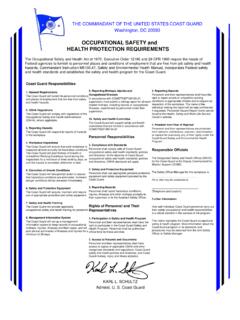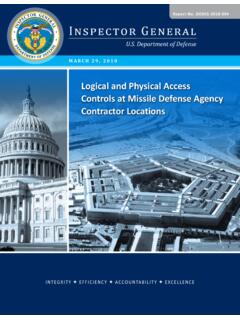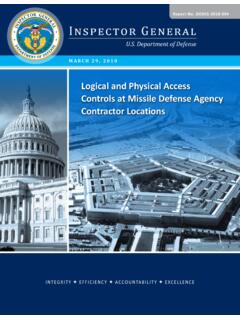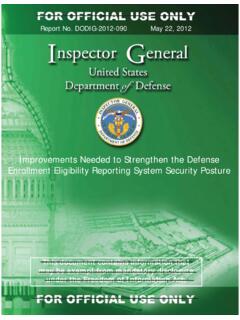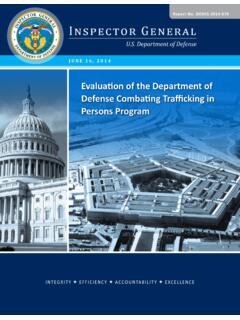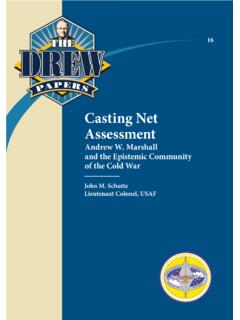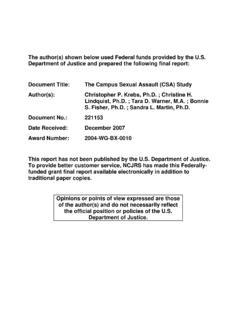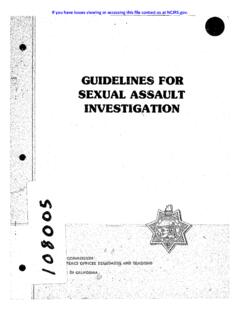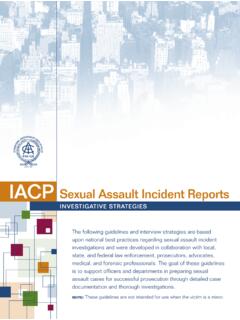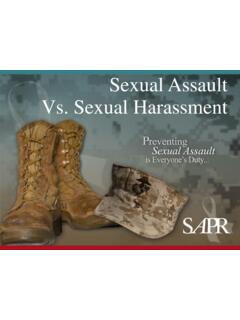Transcription of Department of Defense Fiscal Year 2019 Annual Report on ...
1 0 DOD SAPRO Department of Defense Annual Report on sexual assault in the Military Fiscal Year 2019 1 DOD SAPRO Department of Defense Annual Report on sexual assault in the Military Fiscal Year 2019 The estimated cost of this Report for the Department of Defense is approximately $2,367,000 for the 2019 Fiscal Year. This includes $1,863,000 in expenses and $504,000 in labor. Generated on 2020 Apr17 RefID: D-A4BC881 2 DOD SAPRO Table of Contents Executive Summary .. 3 Introduction ..10 Unit Climate ..11 sexual assault Reporting.
2 14 Victim Assistance ..17 Efforts to Reduce and Stop sexual assault ..20 Way Forward ..24 Appendices Appendix A: Additional Accomplishments, Activities, and Outreach Appendix B: Statistical Data on sexual assault Appendix C: Metrics and Non-Metrics on sexual assault Appendix D: Aggregate DOD Data Matrices Appendix E: Safe Helpline Data Appendix F: sexual Harassment Assessment Appendix G: Domestic Abuse-Related sexual assault Appendix H: Child sexual Abuse Appendix I: Acronyms List Enclosures Enclosure 1: Department of the Army Enclosure 2: Department of the Navy Enclosure 3: Department of the Air Force Enclosure 4: National Guard Bureau Annexes Annex 1.
3 2019 Military Service Gender Relations Focus Groups Overview Report Annex 2: 2019 Workplace and Gender Relations Survey of Reserve Component Members Overview Report 3 DOD SAPRO Executive Summary The Department of Defense continues to address sexual assault comprehensively. The Department s approach focuses on prevention by addressing problematic culture and preparing leaders at all levels to promote healthy unit climates. In addition, the sexual assault Prevention and Response Program offers reporting options, including confidential venues, that respect victims individual situations and desired approach to recovery.
4 This year s Annual Report provides an update on the Department s efforts to combat sexual assault and harassment in the military force, and includes sexual assault reporting information, feedback from focus groups, and updates on efforts to prevent and respond to sexual assault in Fiscal Year 2019 (October 1, 2018 to September 30, 2019). Current State and Enduring ActionsThe Department of Defense strives to advance a military culture free from sexual assault . The Department made progress reducing sexual assault and increasing help-seeking and reporting between 2006 and 2016.
5 However, the Fiscal Year 2018 scientific survey of the active force found that the estimated past-year prevalence (number of Service members indicating an experience) of sexual assault increased for women, primarily those aged 17 to 24. Estimated prevalence for men remained unchanged. In May 2019, the then-acting Secretary of Defense issued a Call to Action memorandum to focus Department actions on addressing sexual assault and related risk factors, such as sexual harassment, workplace incivility, and gender discrimination. The Call to Action memorandum directed the Department and Military Services to: Provide commanders with improved means to assess and address risk factors in military units Prepare new leaders and first-line supervisors to act upon misconduct that heightens risk Implement the Catch a Serial Offender Program (CATCH) to help address barriers to reporting sexual assault April 2020 REPORTING REQUIREMENT Congress requires the Department to provide an Annual Report on sexual assaults involving members of the United States Armed Forces.
6 This Report satisfies that requirement. The Department uses the phrase sexual assault to refer to a range of crimes, including rape, sexual assault , forcible sodomy, aggravated sexual contact, abusive sexual contact, and attempts to commit these offenses, as defined by the Uniform Code of Military Justice. No sexual assault prevalence survey for the active force was required or conducted this year. THIS YEAR S FINDINGS: Reports of sexual assault made to the DOD increased by 3 percent; however, this cannot be interpreted as an increase in sexual assault prevalence among the active duty force because a prevalence study was not conducted this year.
7 Focus Groups with junior enlisted members and first responders indicated that the Department s 2019 initiatives targeted the right personnel and activities to drive change. The CATCH A Serial Offender Program launched in August 2019, with Department -wide publicity and participation thereafter. 4 DOD SAPRO Implement sexual assault Accountability and Investigation Task Force recommendations to improve accountability, comprehensive support to victims, and protection of rights for both the victim and the accused Execute the sexual assault Prevention Plan of Action to ensure initiatives to reduce and stop sexual assault have the best chance for success Fiscal Year 2019 Reporting Requirements Congress requires the Department to provide an Annual Report on sexual assault in the Military by April 30 each year.
8 This Report covers sexual assault allegations made during Fiscal Year 2019. Enclosed with this Report are supplementary reports from the Secretaries of the Military Departments and the Chief of the National Guard Bureau. This Report also includes feedback from 61 focus groups conducted with 493 active duty members and first responders held at 8 installations throughout the continental United States. First responder participants included civilian and active duty personnel who are first responders to sexual assault , including sexual assault Response Coordinators, Victim Advocates, healthcare personnel, law enforcement, Military Criminal Investigative Organizations, judge advocates, and chaplains.
9 Focus group results provided in the Report are not generalizable to the full population of the Military. Themes should be considered the opinions of focus group participants only and not those of all Service members. Per Congressional mandates, the Department did not conduct an active duty sexual assault prevalence survey this year. Lastly, findings from a scientific survey of the Reserve Component are included. Fiscal Year 2019 Focus Areas The Fiscal Year 2019 Report serves as the Department s assessment of the Military Services response and prevention systems from October 1, 2018 to September 30, 2019.
10 This Report focuses on strengths and challenges in the Military Services sexual assault response and prevention systems in the following areas: Unit Climate sexual assault Reporting Victim Assistance Efforts to Reduce and Stop sexual assault THIS YEAR S FINDINGS (CONTINUED): Assessment of the Department and Service headquarters primary prevention capacities found similar strengths and challenges. Most strengths included leadership support and collaborative relationships to enhance ongoing prevention activities. Challenges included not having a fully empowered workforce and a common set of metrics to assess prevention effectiveness.
